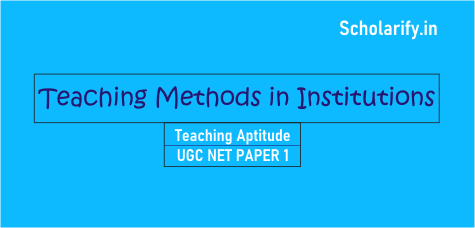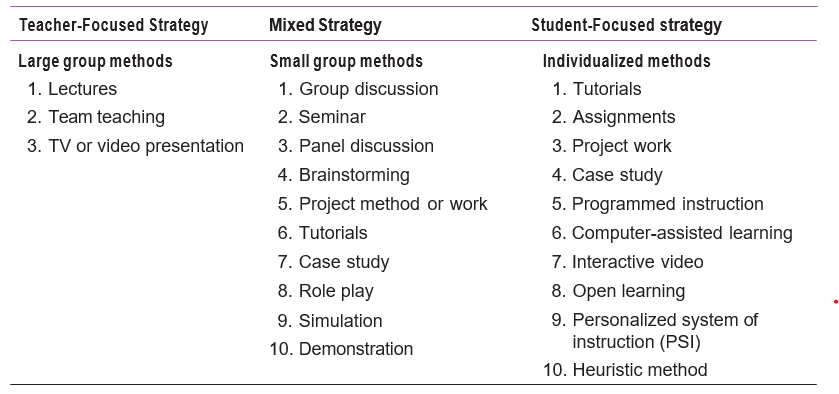
Teaching Methods: Teaching is both, art and science. It requires mastermind creativity that the students of different nature and community should be handled carefully. Therefore, it is an art. On the other hand, it calls for the exercise of talent and creativity making it and involving repertoire of techniques, procedures, and skills that can be studied systematically, described, and improved, making it science.
Methods of Teaching in Institutions of Higher Learning
The teaching profession has successfully faced many challenges and transformations and adopted recent sophistication and technological innovations suitably. All these developments have helped the teaching community to regain a high status in academic campuses worldwide.
The principles of learning and teaching are the tools available to a teacher to teach in a classroom or through TV. Successful teaching needs systematic planning and careful execution. Teaching is done in sequential steps. These steps are called the phases.
The teaching act follows in three stages:
- Pre-active phase: It is the planning phase.
- Inter-Active Phase: It concerns the implementation and carrying out what has been planned. Therefore, it is a stage of actual teaching.
- Post-Active Phase: This phase concerns the evaluation activities, which serve as feedback for improvement.
There are five steps involved in the methods of teaching.
- Preparation
- Presentation
- Comparison
- Generalization
- Application
Teaching Methods According to different Schools of Philosophy
Methods by idealism
Buttler is right when he says, “Idealists consider themselves creators and determiners of methods, not devotees of someone method.” They speak of the general nature of teaching methods only. They do not specify any method to be adopted in the centres of learning. Therefore, the method is the weakest aspect of the philosophy of idealism. Different idealists have adopted different methods.
Socrates laid adopted the question method. Plato, his disciple, changed the question method into the conversational method and made it logical. His disciple, Aristotle followed inductive and deductive methods. Hegel adopted a logical method. Pestalozzi adopted the self-activity method.
Herbart on methods says, “I have no conception of education without instruction and do not acknowledge any instruction which does not educate.” He also takes the help of the discussion method and at times suggests debate as a technique of teaching.
For classroom practice, idealists would encourage the use of the discussion and the lecture methods. The discussion method of learning which is popularly known as the Socratic method involves questioning and discussion. It was the method of learning in the Upanishadic period of Indian education. It is also known as the ‘Informal dialectic’ method. Idealists value the use of well-prepared and presented lectures. The lecture should not be a phonographic recitation on facts but a scholarly exposition. It should also not be delivered in an autocratic way. It should be participatory.
Methods by Naturalism
Rousseau considers education as a process of living. Being a process, it lasts throughout life or at least from birth to adult life. It finds its meaning for any particular stage, not on a future state. It is not artificial, harsh, unsympathetic, repressive of all-natural inclinations, by which “the child as a “little man” is made into a “big man” through the hands of the teacher.
Development of the child through the natural process is an enjoyable, rational, harmoniously balanced, ^ useful and hence natural life. The aim of education is achieved not in adult life, but in each succeeding day, whenever life has its natural activities, its appropriate duties, and its corresponding satisfaction. Thus stress is given on direct experience of things. Rousseau, therefore says, “Give your scholar no verbal lessons: he should be taught by experience alone.
Pragmatic Methods
The focus of pragmatic methods of teaching is on the ‘child-in-society’ and his activities therein rather than the book, the teacher, the subject or exclusively the child-of-nature. Learning always occurs as a result of an activity. The teacher has to capitalize upon the activities of children to direct the teaching-learning process. Activity is the basis of all teaching. The child should be enabled to find out information by himself instead of pouring information on him. Children should be encouraged to discover and investigate the facts of life. Education must develop a laboratory habit of mind. The method of teaching should be experimental.
Existentialist Methods
The method of teaching advocated by existentialism is of asking questions, refining answers, asking more questions and pushing the issue until some acceptable conclusion was reached. Existentialists favored the Socratic approach to teaching, as it was inductive, proceeding from the immediate and particular to the abstract and universal. In this method, knowledge and wisdom are gained through personal relationships between the teacher and the pupil.
They give emphasis on individual attention. Since the emphasis is given on individual attention, they prefer home education to school education.
In an existentialist system, the teacher cannot impose upon children his own ideas, ideals, ideologies, and values. Religious education may be imparted, provided there is no scope for indoctrinations. They advocate a method of teaching which can develop creativity among the pupils.
Teaching Methods as recommended by Secondary Education Commission (1952-53)
- The commission suggested that methods of teaching should provide ample opportunities for students to develop clear thinking and clear expression.
- Individual-centred methods and opportunities for practical application of knowledge should be adopted.
- Activity method and project method should be used in school practice.
- Establishing Experimental and Demonstration schools and training in activities such as as scout movement, N.C.C., first aid should be encouraged.
Some Specific Teaching Methods
Inferential Problem-Solving Technique
Inductive and deductive are two important procedures of systematic approaches to problem-solving.
Steps in Inductive Method:
- Recognition of the problem
- Searching for data
- Organisation of data
- Framing tentative solutions
- Elimination
- Verification
Steps in Deductive Method
- Recognition of problem
- Searching for data
- Reviewing
- Formulation of inferences
- Verification
Team-Teaching
Team-teaching is also called co-operative teaching. This is a recent idea in the field of education. M.B. Naik said, “In a team-teaching method, two or more teachers make a plan of the subjects cooperatively, carry it out, and always evaluate its effects on the students periodically.” In team teaching, subject teachers give lectures to a big class. On every working, all the members of the team have a common assembly. Here they discuss the methods used by the fellow-teachers.
Micro-Teaching
Micro-teaching is an innovative teaching technique. It is a new development in the field of teaching. The term micro-teaching was first coined by Dwight Allen of Stanford University in 1963.
Features of micro-teaching
- It is a teacher training technique
- It focuses on developing teaching skills.
- It reduces the class size in five to ten students.
- The size of the topic is also reduced.
- Micro-teaching is a highly individualized training skill.
- It provides feedback for trainee’s performance.
- It is an effective device to prepare competent teachers.
- In this technique, learners are provided with immediate knowledge of the correctness of the response.
Steps in Micro-teaching
- Defining the skill
- Demonstrating the skill
- Planning the lesson
- Teaching the lesson
- Discussion
- Replanning
- Re-teaching
- Rediscussion
- Repeating the cycle until the desired level of skill is achieved.
Question-Answer technique in teaching
No teacher of elementary or secondary subjects can succeed in his instruction, which has not a fair mastery of the art of questioning.
Purposes of questioning:
- To test the knowledge
- To locate the difficulty
- To arouse motivation
- To secure active participation of students.
- To apply knowledge
- To recapitulate the lesson learnt.
- To promote thinking and originality
- To increase self-confidence
- To maintain discipline
- To promote intellectual and social development.
Underlying the need for questioning Parkar Said. “Questioning is the key to all educative activities.”
Teaching Methods for Different Focused Groups

Related Topics
UGC NET Syllabus 2020 (Updated): Paper 1 and 2 (Download)
Solved Question Papers of UGC NET Paper 1
UGC NET Study Materials for Paper 1 (Download PDF)
MPhil and PhD Fellowship
Thank you for providing good content.
May we ask the difference between this free material and the paid one?
The study materials are almost same but in paid one, you will get Quality MCQs of all topics of UGC NET Paper 1.
For running this website without any interruption, we charge for the PDF version (with MCQ) of the study material.
Regards,
Scholarify.in
Very good content. thank you so much for providing this
Thanks for the compliment.
net purpose very important subject add this site .thank you very much
Very helpful
Thanks for the appreciation.
Thanku so much for providing this wonderful content. 🙏🙏 And the most important thing is that ki ye hr language m available h. 😊😊 Explain in very simple language. Jo students k dimag m direct enter krta h . Thanku once again.❤️❤️😊😊😊🥳🥳
Thanks for the appreciation.
Thank you for making our difficult task into a simpler one
this is very useful data
I personally loved the contents and most importantly what is loved the most is that these contents are well structured and well explained point to point! (: Keep growing ! & Thankyou ..